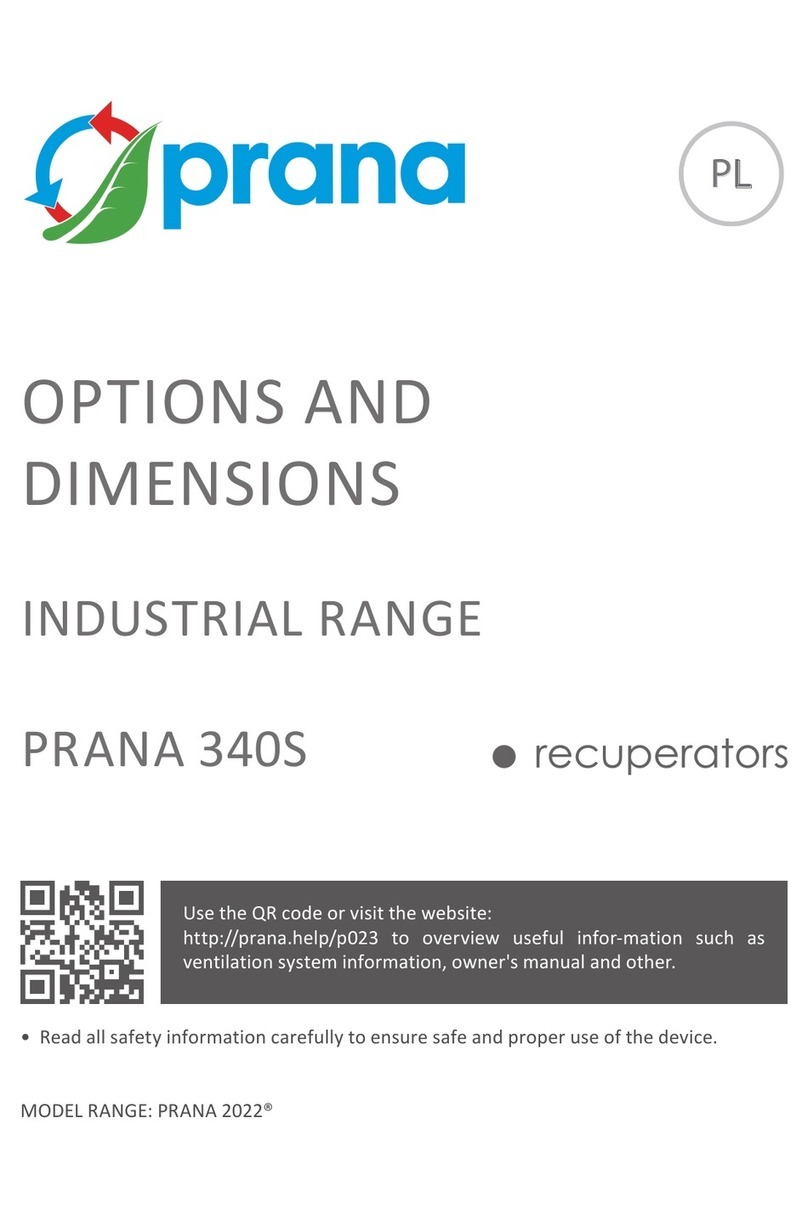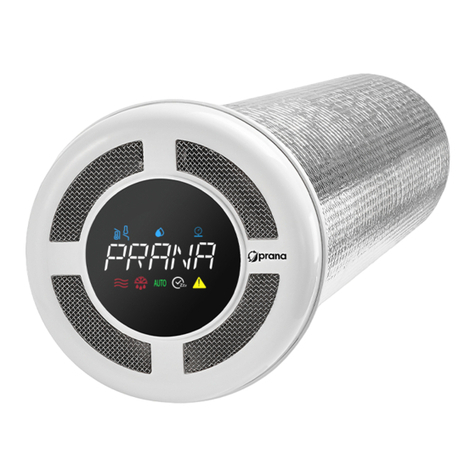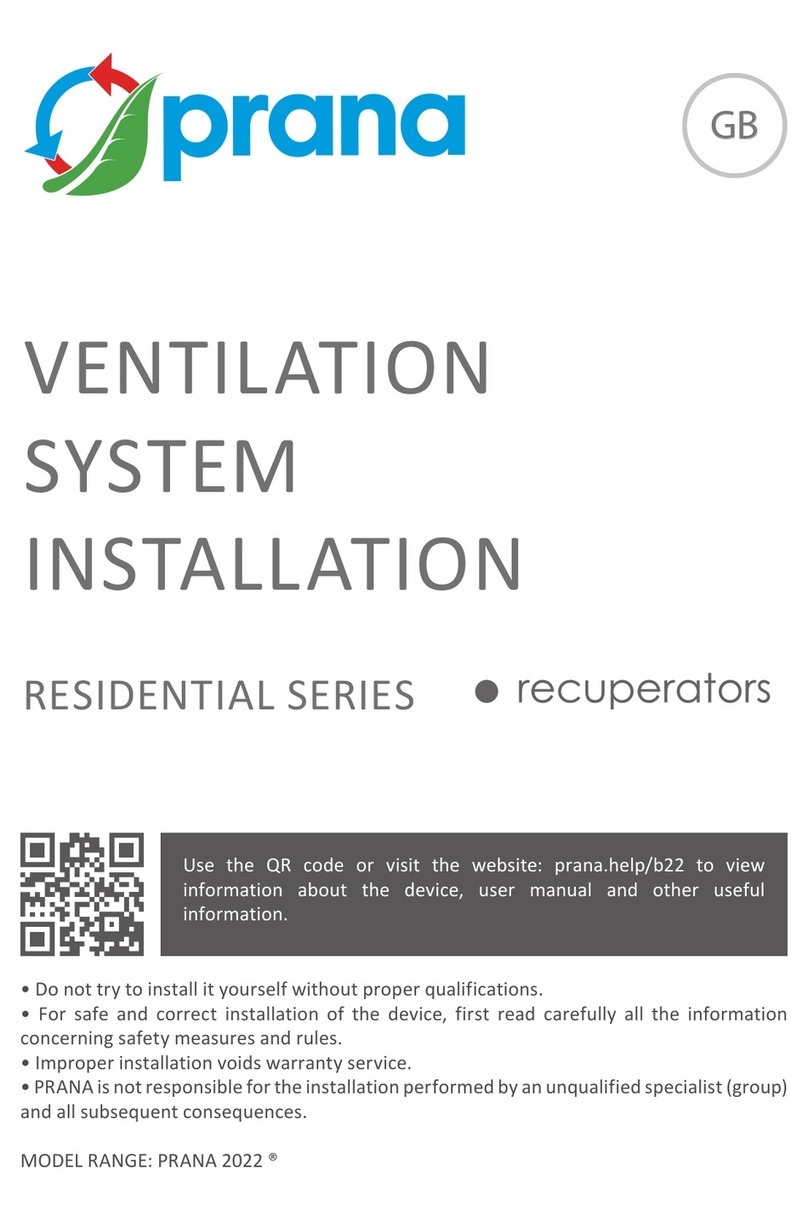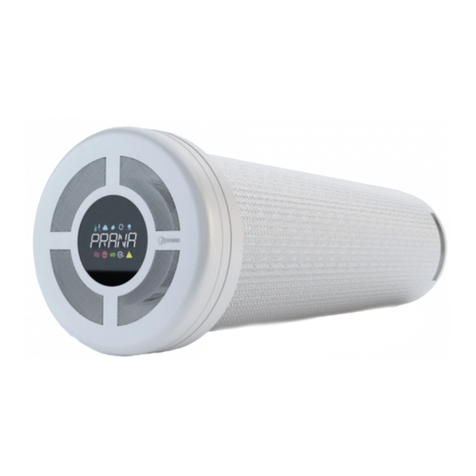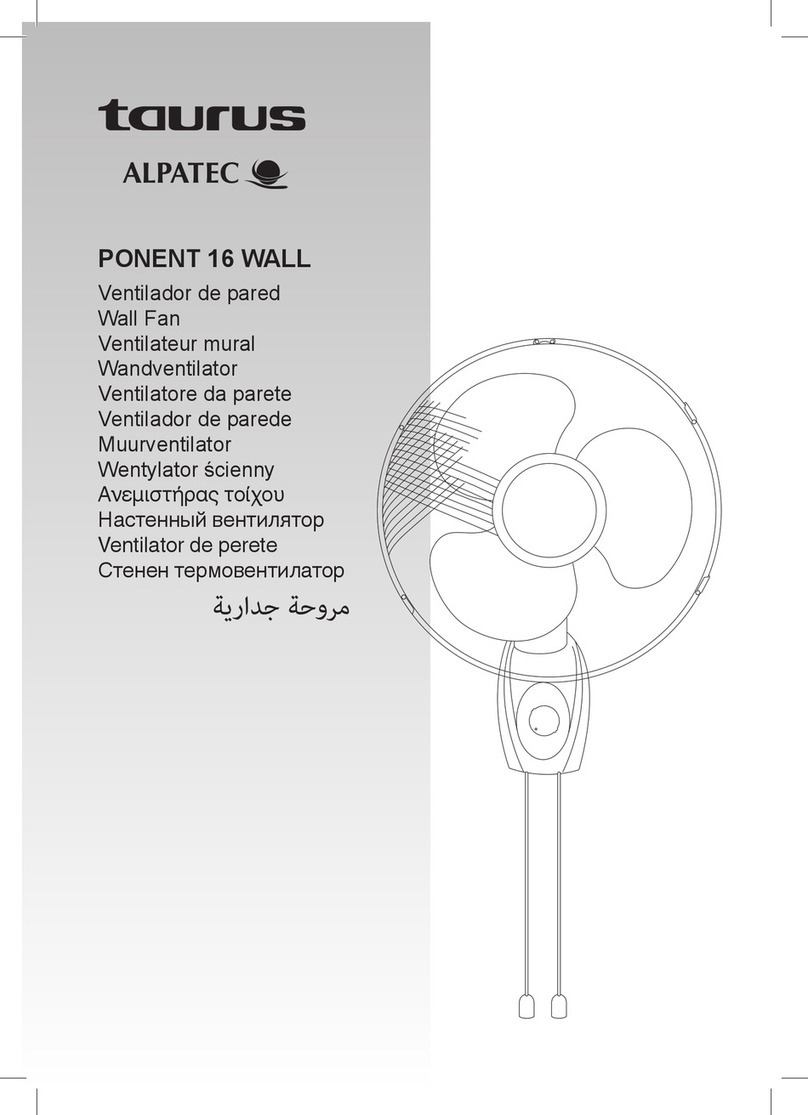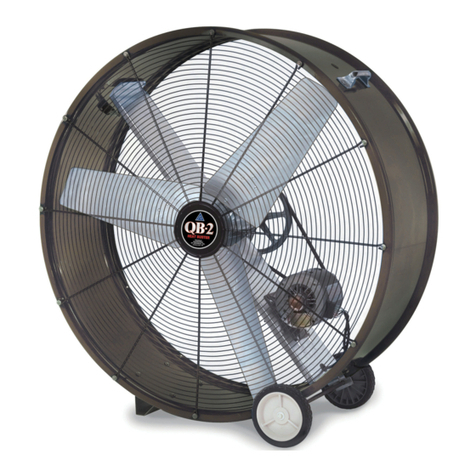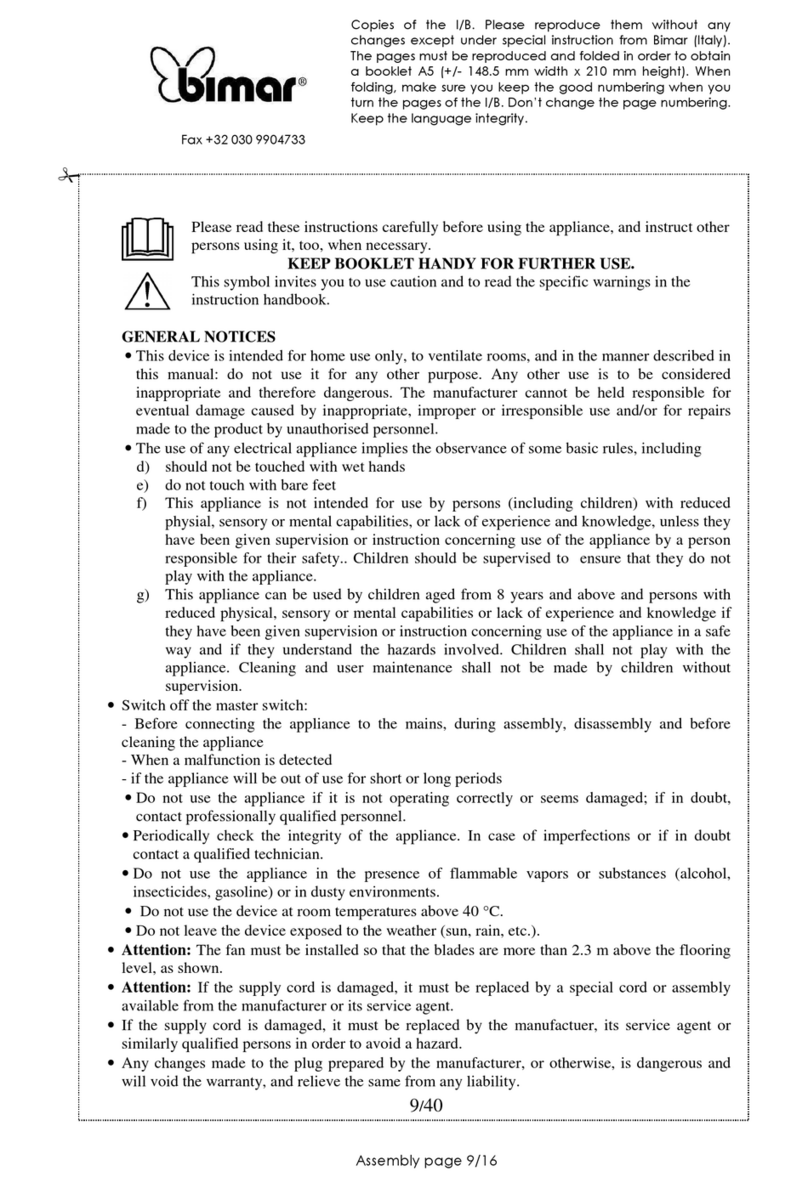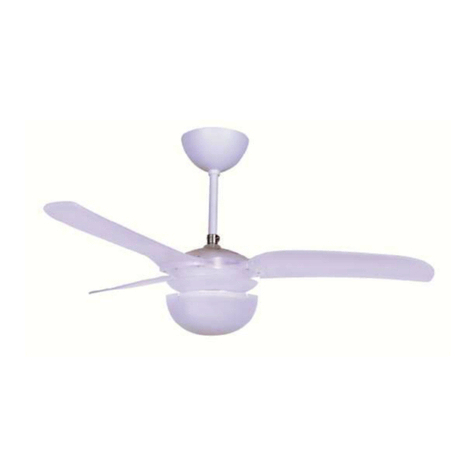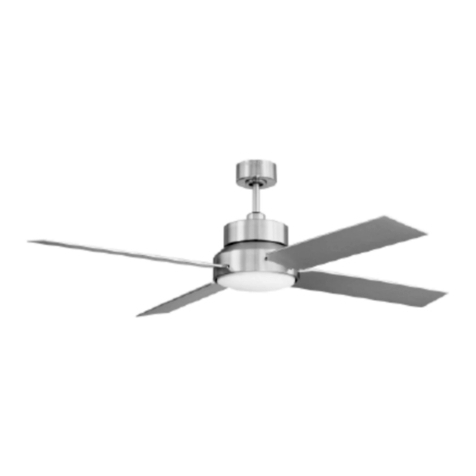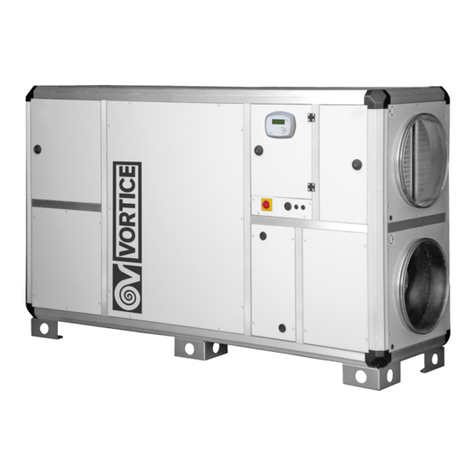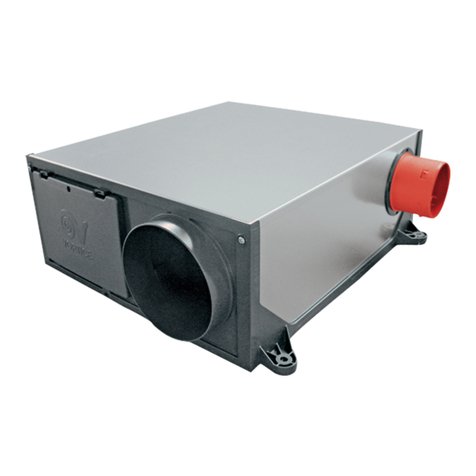prana 150 Operator's manual

1
TECHNICAL-OPERATING
DOCUMENTATION
Infl ow and exhaust ventilation system
with heat recovery
PRANA-150
PRANA-200C
PRANA-200G
8

2
INTENDED USE
PRINCIPLE OF WORK
The basis of the technical solution for recuperation ventilation is the countercurrent, with a
continuous thermal cycle, a copper heat exchanger, which makes it possible to form two
different-directed airfl ows in the volume of one cylinder (Fig. 1).
Warm exhaust air that is removed from the room, passing through a copper heat exchanger
transmits its warmth to the counter stream of fresh air from the outside.
The system allows recover heat, which contributes to increasing the overall recuprration rate
and allows maintain the optimum humidity mode in the room. Taking into account that air
streams are separated and regulated at levels “infl ow” – “exhaust”», there is no mixing of
different-directional air fl ows.
High velocity of the fl ow with suffi cient heat transfer effi ciency ensures removal of up to
90% moisture in a dispersed state, preventing its condensation and freezing of the heat
exchanger at low ambient temperatures.
DESCRIPTION OF THE SYSTEM
Ventilation systems “PRANA-150”, “PRANA-200C”, “PRANA-200G” are intended for creation
and maintenance of healthy microclimate in premises.
These systems are recommended for use in residential and public facilities (apartments,
houses, offi ce premises, educational establishments, kindergartens, etc.).
Monoblocks of the centralized anti-current infl ow-exhaust ventilation.
PRANA-150 and PRANA-200 belong to the category of innovative and reliable products
aimed at creating and maintaining a healthy microclimate in premises of various functional
purposes.
High energy effi ciency and signifi cant air exchange capabilities make it possible to apply
these ventilation systems for organizing domestic ventilation.
Technologically, the system is a monoblock with high-effi ciency counter-current
copperrecuperator ready to use in accordance with the design and assembly tasks and
conditions.
Fig.1. The principle of operation of recuperator PRANA-150, PRANA-200C, PRANA-200G
Cold fresh air
from outside
100-150 mm
from the ceiling
Removal of warm return
air from the premises
Supply & exhaust are
operating simultaneously
copper
heat exchanger
Preheated fresh air
from outside
Unit slope
3-5 degrees
Removal of the air
from the premises

3
ADDITIONAL FUNCTIONS
The function of “heating with minimally-raised temperature”
For additional comfort in equipping residential premises with ventilation systems PRANA of
residential-and-public and semi-industrial series, the function of air “heating with minimally-
raised temperature” is provided for. It can be switched on by pressing the “On heating with
minimally-raised temperature” button on the remote control or in a mobile application (see
the remote control manual included in the list of standard equipment).
After having activated the function of “heating with minimally-raised temperature”, the
temperature of the infl ow air increases by 3-5 ºC.
When the motors are switched off and the cover of the recuperator is open, this function
additionally plays the role of an air heat curtain.
WARNING! DO NOT SWITCH ON «heating with minimally-raised temperature» , if the outside
air temperature is +20 ºС and above!
Function “Winter Mode”
Function “Winter Mode” is intended to prevent the icing of condensate drainage during the
cold season or to freeze it if icing has occurred.
WARNING! To avoid icing and to ensure the system operates correctly at the minus
temperature from the outside - the use of the Winter Mode is mandatory.
MAIN TECHNICAL CHARACTERISTICS
PRANA 150 PRANA 200G PRANA 200C
Diameter of the working module, mm
with thermal insulation, mm 150
160 200
210 200
210
Diameter of the mounting hole, mm
Length of the working module, mm
≥162
≥475
≥215
≥440
≥215
≥500
Recommended area of the premises, m 2 <60 <60 <120
Amounts of air exchange during recovery, m3/h;
(the infl ow and exhaust work simultaneously):
- i n fl o w
-exhaust
-night / minimal
- passive mode
115
105
25
6
135
125
25
10
235
220
40
10
Energy consumption, W * h:
recuperator
“mini-after-heating” 7-32
55 7-32
55 12-54
55
Recovery effi ciency, % 91 92 93
Acoustic pressure from the product at a distance,
dB (A):
3m
1m 13/24
21/36 13/24
21/36 13/24
22/38
Weight of the system in individual packing ≥ 4,4 ≥ 5,8 ≥ 6,0
The size of the packing box, mm (LxHxW) ≥750х210х210 ≥750х260х260 ≥750х260х260
Power supply: AC: 230 ± 10% V. Class of insulation: II. Degree of protection: IP 24.
Control: remote control, mobile application.
The body of the system is thermally insulated. Double protection against frontal blasting.
The function of “heating with minimally-raised temperature” and “freezing”.
The established service life of the system: 10 years. The warranty period: 2 years.
The use of the system is designed for long-term operation at air temperature in the range
from -30 ºС to +50 ºС.

4
In mode «AUTO» after engine shutdown, «Winter mode» will work for 30 minutes to prevent
icing in the system, which may result in reduced effi ciency or condensate drainage
complications.
Preheating element (additional option)
Recuperators that will be used in rooms with excessive humidity in the cold climate are
recommended to be equipped with an additional heating element.
Passive mode
The operating mode of the ventilation system with the open lid of the recuperator and
switched off motors. It lies in the movement of uncontrolled airfl ows through the recuperator
due to the difference in pressure and temperature inside and outside the premises. It is
allowed to use, when the difference between outside and inside temperatures is no more
than 5 o C.
Defrosting
WARNING! In the cold season, the improper operation of the recuperator is likely to freeze it!
When freezing, it is necessary to activate function «mini-heating» with engine switched off
for at least 60 minutes, and let it freeze, then turn on the recuperator to the required mode.
switched off motors
+
the “heating with
minimally-raised
temperature” switched on
turn on
the desired mode
1.
2.
2.
9
switched off motors
switched off motors
Fig. 2. Defrosting

5
OVERALL DIMENSIONS
Fig. 3. The overall dimensions and the dimensions of ventilation system “PRANA-150”, “PRANA-200G”,
“PRANA-200C”:
a) the ventilation grid and air intake in the premises;
b) monoblock, side view;
c) the ventilation grid and air intake from the outside.
535
475
35
mm
500mm
475
a)
a)
a)
a)
b)
b)
b)
b)
c)
c)
c)
c)

6
The infl ow and exhaust ventilation system with heat recovery “PRANA” is a monoblock ready
for use in accordance with design and assembly tasks and conditions.
The system is mounted in a hole of the appropriate diameter in the upper part of the wall
adjoining the outside, at a distance of no less than 100-150 mm from the ceiling or walls. The
through hole should be a slope of 3-5 degrees towards the outside. The operating module of
the ventilation system is mounted in the hole using a seal (Fig. 4).
The length of the working module should correspond to the thickness of the wall in which
the installation will be carried out. In order to ensure the normal operation of the system, it
is necessary that its body facing the the outside extends beyond the wall by 1-2 cm to the
beginning of the air intake (Fig. 4).
INSTALATION
Fig. 4. The diagram of installing the recuperator in the wall.
airborne
airborne
grille
grille
airborne
grille
airborne
airborne
grille
airborne
> 50 mm
> 50 mm
unit slope
unit slope
3-5 degrees
3-5 degrees
unit slope
3-5 degrees
unit slope
unit slope
3-5 degrees
unit slope
100-150 mm
from the ceiling
sealant
sealant
sealant
air intake
Fig. 5. An example of mounting of the recuperator “PRANA-150”, “PRANA-200G”, “PRANA-200C”.
Other preparatory works:
- preparation of the hole for installing the switch and preparation of the grooves for the
installation of the electrical supply network between the system, the switch and the place of
connection of the system to the power supply source.

7
CONNECTING TO THE ELECTRICAL SUPPLY NETWORK
Connecting the recuperator to the electrical supply network, controlling the system from the
remote control.
Disconnect the power supply to the electrical system to which the ventilation system will be
connected.
WARNING! Ensure that the electric power supply is really switched off!
The connection of the ventilation system to the electrical supply network is done using an
electric cable, which is laid from the working module (standard equipment).
In the event that the electrical system is not laid to the mounting hole, the electric cable
from the recuperator should be connected to the electrical supply network in the distribution
box according to the diagram in Fig. 6: You must connect the contact terminals 1 and 2 in
parallel, or install in the cable an electrical connector that meets the above parameters for
quick connecting and disconnecting electrical appliances. Electrical connectors are not
included in the list of the standard equipment.
If the cable of the electrical supply network of the building has been laid to the mounting
hole, then the power supply to the working module cable is carried out in the immediate
vicinity of the body of the recuperator. Shorten the electric cable from the recuperator to a
length that is convenient for electrical connection.
All electrical cables used in the installation should have the cross-section of 0.5-0.75 mm².
The operation of the system is controlled using a remote control or mobile application that
controls the operation of the fans installed in the body of the ventilation system (it turns on,
regulates and turns off).
The PRANA 150 / 200G / 200C recuperators are adapted to an existing electrical network in
an automatic mode, without the use of software. This signifi cantly reduces the noise indicators
of the equipment and allows ensure the the noise characteristics of the ventilation system
declared in the technical passport.
WARNING! After having connected the ventilation system to the electricity supply network,
it is necessary:
1. to supply electrical power to the system.
2. to check the operation of the fans in different operating modes, using control units.
1
2
Fig. 6. Connection of the recuperator to the electrical supply network in the case of controlling the
system from the remote control or using a mobile application.

8
START-UP
The fi rst start-up of the system should be carried out by a specialist who has theoretical
knowledge and haspractical skills in the electrical installation of this ventilation system.
Before starting-up, it is necessary to check:
- if the connection to the electrical supply network has been performed correctly (according
to the mark in Fig. 6);
- if the air in is open;
- if the ventilation system is functioning properly.
WARNING!Before switching on the system, open the air intake as indicated in the photo
below:
OPERATION
During operation, it is necessary to periodically check:
- the quality of function of the fans;
- the correspondence of the graphic symbols of the indication;
- correct operation of the device in accordance with the control devices.
The device must be switched off in case of:
- excessive oscillations and noise;
- damage to the elements of the device body;
- damage to the insulation of the electric cable;
- damage to the elements of automation;
- the temperature of the outside air is below -30 ºС.
1. The lid is closed. Do not switch on the system,
when the lid is closed.
2. Smoothly pull the cover. The system is ready
for starting-up.
The PRANA 150 / 200G / 200C recuperators are adapted to an existing electrical supply net
work automatically, without the use of software. It signifi cantly reduces the noise indicators
of the equipment and allows ensure the noise characteristics of the ventilation system
declared in the technical passport.
ADAPTATION TO THE ELECTRICAL SUPPLY NETWORK

9
1. Press the “Switch off” button on the remote
control. Switch off the ventilation system. 2. De-energize the ventilation system.
7. Extract the heat exchanger and fans
from the body.
6. Unscrew the self-tapping screws through
special openings. Remove the fl ange.
MAINTENANCE
The maintenance consists in periodic (recommended 1-2 times a year) and preventive
inspection of surfaces of the fans and the heat exchanger and, if necessary, in cleaning
them. The procedure for disassembling / assembling the device for / after cleaning:
6. Unscrew the self-tapping screws through
special openings. Remove the fl ange.
7. Extract the heat exchanger and fans
from the body.
3. Open the lid of the recuperator. 4. Turn the fasteners of the lid and remove it.
5. Disconnect the cable and remove the power wires by
pressing the terminals. Remove the lid.

10
ASSEMBLY IN THE REVERSE ORDER
The technological process provides for 100% inbound quality control for all components,
as well as double 100% inbound control after their manufacture and 24-hour run in the
maximum power mode.
Transportation and storage of the products in individual packing boxes is ensured in a
horizontal position.
Keep the recuperator in the factory packaging under the cover or (in enclosed space) with
relative humidity of air of no more than 70% and air temperature from -20˚С to + 40˚С.
TRANSPORTATION AND STORAGE RULES
12. The drain in the heat exchanger and
the body must coincide and be below
during the installation.
14. The fl ange must be installed correctly;
the larger protrusion of the should be below.
11. Clean the heat exchanger in adry or, if
necessary, in a wet manner.
WARNING!
Before rinsing or wet cleaning of the
heat exchanger, make sure that all
the electrical components and parts
are removed from the heat exchanger
(except for the components of “heating
with minimally-raised temperature”and
“heating the condensate drainage with
raised temperature”.
QUALITY
9. Unscrew the self-tapping screws.
Remove the fans on both sides.
10. Remove the blades from the fan
housings and clean them in a dry manner.
12. The drain in the heat exchanger and
>
9. Unscrew the self-tapping screws.
Remove the fans on both sides.
10. Remove the blades from the fan
housings and clean them in a dry manner.

11
- Ventilation system.
- Technical passport for the system.
- Technical (warranty) card.
- Remote control.
- Manual for the remote control.
- Packing box
SCOPE OF DELIVERY
SAFETY REQUIREMENT
All electrical installation works (maintenance) must be carried out only by a qualifi ed
specialist with a category of admission to such works.
Ensure that during installation, the provisions, mechanical and electrical installation rules
and norms valid in the country, in which the installation is carried out, are observed.
WARNING! All installation and electrical works relating to the connection (maintenance) are
carried out only after the device is disconnected from the electrical supply network.
WARNING! Do not operate the ventilation system, if there is a threat that foreign objects may
enter the infl ow part of the body, which objects may jam or damage the impeller of any of
the two fans.
WARNING! Do not operate the ventilation system in premises, where the air contains
aggressive substances and does not correspond to the working temperature regime.
After commissioning, the ventilation system must comply with the provisions of the following
directives:
- Directive 2014/35 / EU. Low Voltage Directive (LVD);
- Directive 2006/42 / EU. Safety of Machinery mechanisms;
- Directive 2004/108 / EU. Electromagnetic Compatibility (EMC);
- Directive 2011/65 / EU. Restriction of Hazardous Substances (RoHS).

12
Other manuals for 150
1
This manual suits for next models
2
Table of contents
Other prana Fan manuals
Popular Fan manuals by other brands
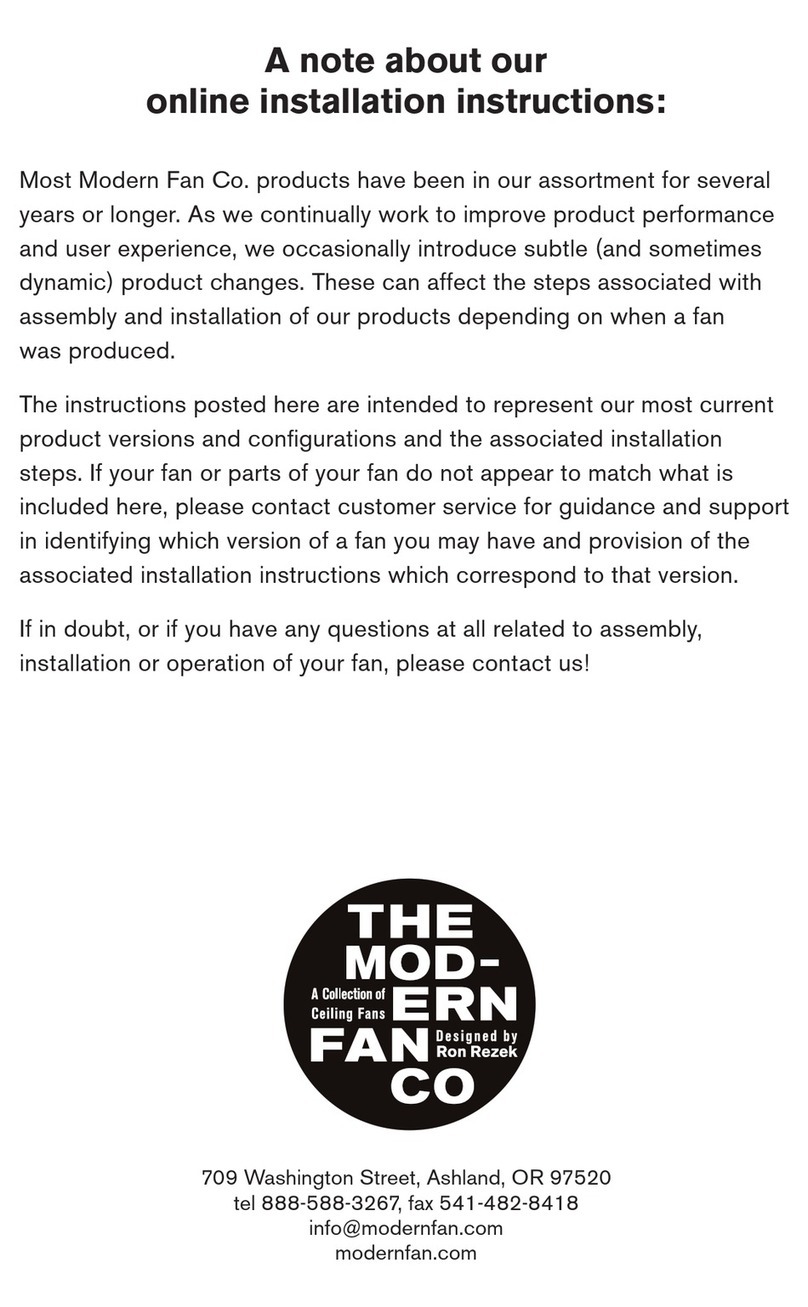
The Modern Fan Company
The Modern Fan Company Lapa Flush Installation instructions and owner's manual
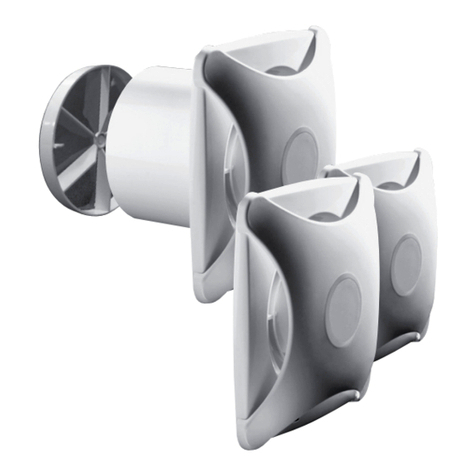
Myson
Myson X 100 TH user manual

HealthyAir
HealthyAir Source Capture HA-SCV-G1-WS owner's manual
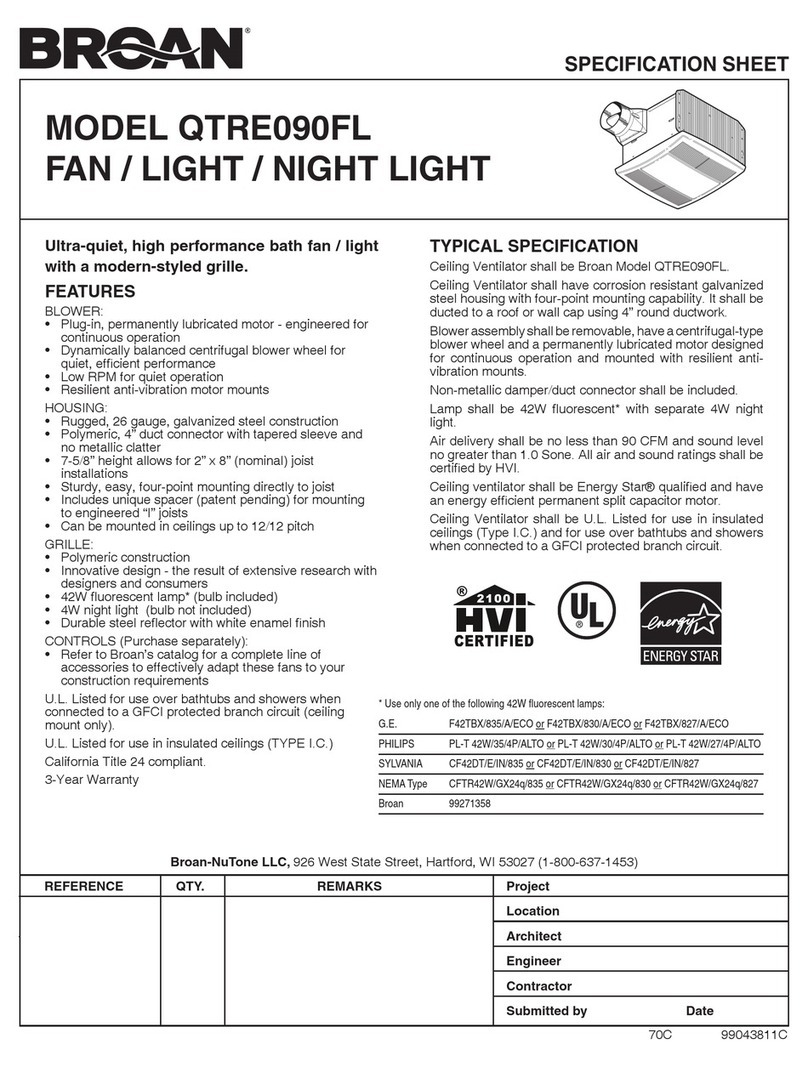
NuTone
NuTone QTRE090FL Specification sheet
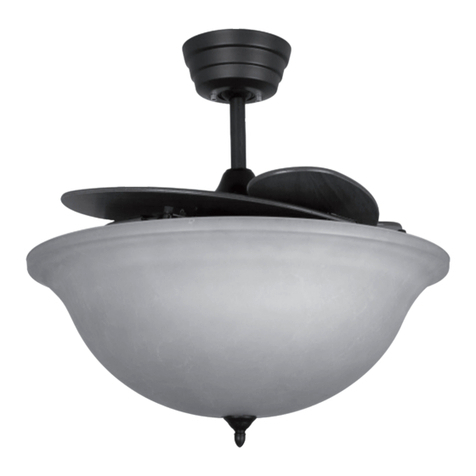
Fanimation
Fanimation Air Shadow FP810 Series owner's manual
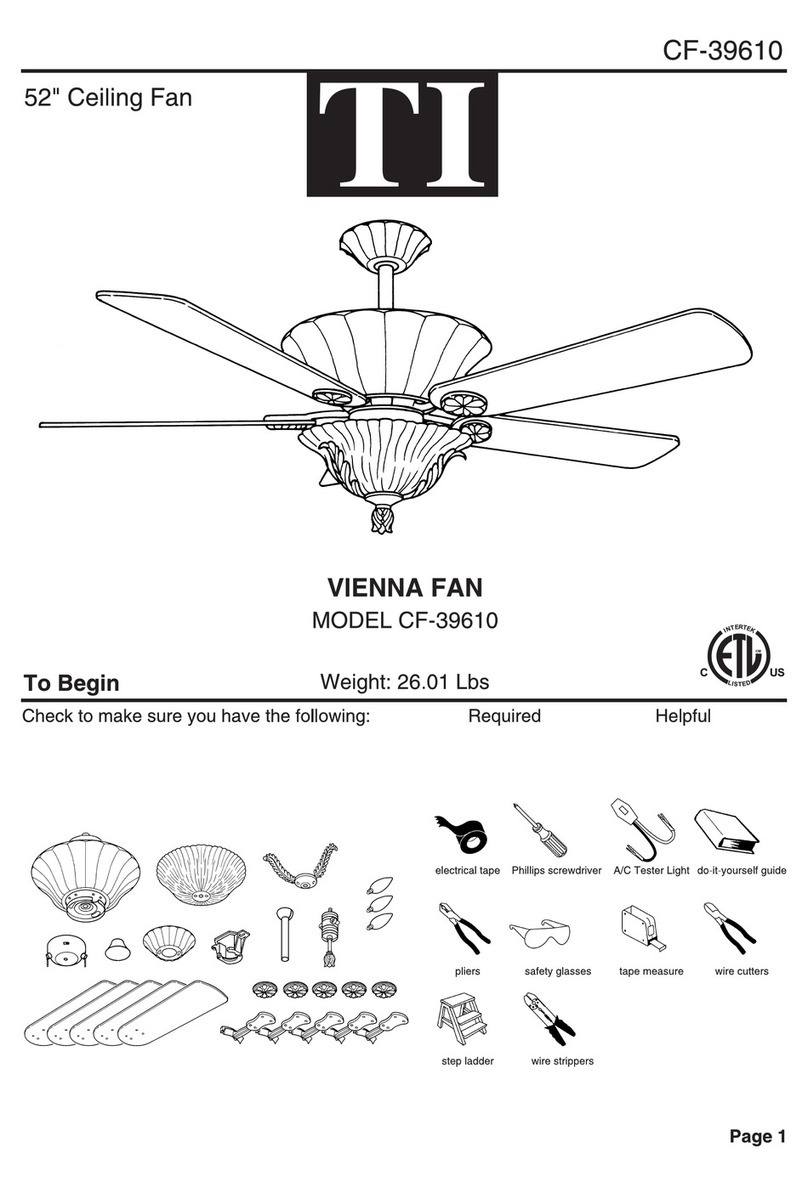
TI
TI CF-39610 installation instructions

